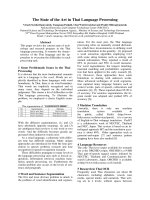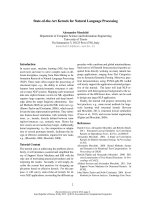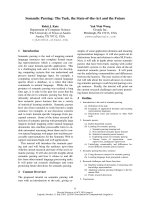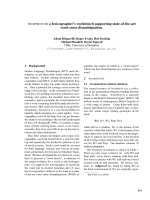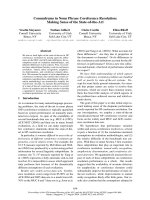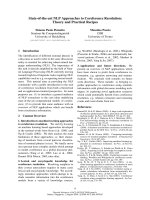- Trang chủ >>
- Khoa Học Tự Nhiên >>
- Vật lý
nanotechnology in medical applications state of the art in materials and devices
Bạn đang xem bản rút gọn của tài liệu. Xem và tải ngay bản đầy đủ của tài liệu tại đây (1.72 MB, 123 trang )
RIVM report 265001001/2005
Nanotechnology in medical applications:
state-of-the-art in materials and devices
B. Roszek
1
, W.H. de Jong
2
and R.E. Geertsma
1
This investigation has been performed by order and for the account of the Department of
Pharmaceutical Affairs and Medical Technology of the Dutch Ministry of Health, Welfare
and Sports, within the framework of project V/265001, Support for Policy on Medical
Technology.
RIVM, P.O. Box 1, 3720 BA Bilthoven, telephone: 31 - 30 - 274 91 11; telefax: 31 - 30 - 274 29 71
Contact:
Dr. B. Roszek,
1
Centre for Biological Medicines and Medical Technology, RIVM
2
Laboratory for Toxicology, Pathology and Genetics, RIVM
page 2 of 123 RIVM report 265001001
RIVM report 265001001 page 3 of 123
Abstract
Nanotechnology in medical applications: state-of-the-art in materials and devices
Nanotechnology is an extremely powerful emerging technology, which is expected to have a
substantial impact on medical technology now and in the future. The potential impact of
novel nanomedical applications on disease diagnosis, therapy, and prevention is foreseen to
change health care in a fundamental way. Furthermore, therapeutic selection can increasingly
be tailored to each patient’s profile. This report presents the state-of-the-art in the area of
promising nanotechnology approaches for medical technology. In particular, relevant
applications are reported in surgery, cancer diagnosis and therapy, biodetection of disease
markers, molecular imaging, implant technology, tissue engineering, and devices for drug,
protein, gene and radionuclide delivery. Many medical nanotechnology applications are still
in their infancy. However, an increasing number of products is currently under clinical
investigation and some products are already commercially available, such as surgical blades
and suture needles, contrast-enhancing agents for magnetic resonance imaging, bone
replacement materials, wound dressings, anti-microbial textiles, chips for in vitro molecular
diagnostics, microcantilevers, and microneedles.
Keywords: nanotechnology; medical technology; biosensors; molecular imaging; implants;
cancer diagnostics; cancer therapy; in vitro diagnostics
page 4 of 123 RIVM report 265001001
RIVM report 265001001 page 5 of 123
Rapport in het kort
Nanotechnologie in medische toepassingen: stand der wetenschap in materialen en
producten
Nanotechnologie is een uitermate krachtige, opkomende technologie die op dit moment al
toegepast wordt en in de toekomst een aanzienlijke invloed zal hebben op de medische
technologie. Innovatieve nanomedische toepassingen kunnen de gezondheidszorg op
fundamentele wijze veranderen, omdat er nieuwe mogelijkheden beschikbaar komen voor
diagnose, behandeling en preventie van ziekte. Verder kunnen behandelmethodes in
toenemende mate precies op maat worden gemaakt gebruikmakend van het profiel van de
patiënt. Dit rapport geeft een overzicht van de “state-of-the-art” op het gebied van
veelbelovende nanotechnologische ontwikkelingen in de medische technologie. Met name
worden relevante toepassingen besproken in chirurgie, diagnose en behandeling van kanker,
bepaling van ziekte-specifieke stoffen in het lichaam, beeldvormende technieken,
implantaten, tissue engineering en toediening van geneesmiddelen, eiwitten, genen en
radionucliden. Veel toepassingen van nanotechnologie in de medische technologie staan nog
in de kinderschoenen. Een toenemend aantal producten wordt echter momenteel onderzocht
in klinische studies en sommige zijn al commercieel verkrijgbaar, waaronder chirurgische
mesjes en hechtnaalden, contrastmiddelen voor beeldvorming met magnetische resonantie,
botvervangende materialen, wondbehandelingsproducten, antimicrobieel textiel, chips voor in
vitro moleculaire diagnostiek, “microcantilevers” en micronaalden.
Trefwoorden: nanotechnologie; medische technologie; biosensoren; moleculaire
beeldvorming; implantaten; kankerdiagnostiek; kankertherapie; in vitro diagnostiek
page 6 of 123 RIVM report 265001001
RIVM report 265001001 page 7 of 123
Summary
Nanotechnology is an emerging technology seeking to exploit distinct technological advances
of controlling the structure of materials at a reduced dimensional scale approaching
individual molecules and their organised aggregates or supramolecular structures. Basically,
the nanometre-length scale is creating possibilities for novel materials that can be used for the
construction of devices and systems. Nanotechnology must be distinguished from the
nanoscience enabling such technology. Basically, nanoscience is the study of phenomena and
material properties at nanoscale, while nanotechnology is applying the resulting knowledge to
create novel materials and structures. Knowledge in nanoscience and nanotechnology is
increasing worldwide, leading to great scientific advances. In turn, this is expected to lead to
fundamental changes in the way that materials, devices, and systems are understood and
created. Application in life sciences research, particularly at the cell level sets the stage for an
exciting role of nanotechnology in healthcare.
In this report a general overview of the state-of-the-art in novel nanomaterials and recent
advances of nanotechnology applications are presented, focussing on promising medical
applications. Relevant medical areas are surgery, therapy, diagnostics, imaging, implant
technology, bionics, bio-active surfaces, tissue engineering, textiles, actuators, and delivery
systems. Products which are either commercially available or currently being developed at
several companies are also included, illustrating the significant progress and challenges in
nanotechnology.
Novel nanomaterials are envisaged to have a major impact on a number of different relevant
areas. Materials with high performance and unique properties can be produced that traditional
synthesis/manufacturing methods could not create. Carbon nanotubes and inorganic
nanowires exhibit extraordinary mechanical, electric, electronic, thermal, and optical
properties offering especially the electronic industry properties that few materials platforms
could ever hope to match. Although nanotube/wire electronics has been speculated about for
well over a decade, the first products are now about to reach the market or are beginning to
appear in the form of field emission displays, sensors, and non-volatile memory. Quantum
dots (semiconductor nanocrystals) possess remarkable optical and electronic properties that
can be precisely tuned by changing their size and composition. Due to their relatively
inexpensive and simple synthesis quantum dots have already entered the market for
experimental biomedical imaging applications. Dendrimers (complex spherical
macromolecules) have improved physical, chemical, and biological properties compared to
traditional polymers. Some unique properties are related to their globular shape and the
presence of internal cavities offering the possibility as medical nanovehicles. In addition to
these examples of individual nanoparticles, new or enhanced materials can be constructed
using structural surface modifications of macro-, micro- as well as nanomaterials. Essentially,
an increase in surface area and roughness attributes to an enhancement of absorbent,
adsorbent, and catalytic properties. Control of surface properties at nanolevel was shown to
increase the biocompatibility of the materials.
It is difficult to accurately predict the timescale of developments, but it is anticipated that
within the next few years the application of nanomaterials and nanotechnology-based
manufacturing will have an established role in medical technology. Some surgical aids
already benefit from nano-structured material, such as surgical blades with nanometre-thick
diamond coating and surface roughness in the same order of magnitude, and suture needles
incorporating nano-sized stainless steel particles. Other nanotechnological approaches might
allow for nanosurgery, a minimally invasive alternative to traditional surgery, based on
nanoneedles and laser technologies such as optical tweezers and “nanoscissors”.
page 8 of 123 RIVM report 265001001
Biomedical nanotechnology presents revolutionary opportunities in the fight against many
diseases. An area with near-term potential is detecting molecules associated with diseases
such as cancer, diabetes mellitus, neurodegenerative diseases, as well as detecting
microorganisms and viruses associated with infections, such as pathogenic bacteria, fungi,
and HIV viruses. Macroscale devices constructed from exquisitely sensitive nanoscale
components, such as micro-/nanocantilevers, nanotubes, and nanowires, can detect even the
rarest biomolecular signals at a very early stage of the disease. Development of these devices
is in the proof-of-concept phase, though entering the market may be sooner than expected.
However, a different approach of molecular sensing in vivo involves the use of implantable
sensors which is still hampered by unwanted biofouling impairing long-term stability of
continuous sensors caused by blood components and factors of the immune system.
Nanotechnology might yield nano-structured surfaces preventing this non-specific protein
adsorption.
Molecular imaging is providing increasing power to studies of animal models of disease and
is beginning to be used in clinical investigations as a non-invasive means of monitoring
disease progress and response to therapeutics. Molecular imaging agents will allow clinicians
to detect diseases in its earliest, most treatable, presymptomatic stage. Combination of precise
targeting using specific antibodies and imaging enhancement properties of nanoparticles are
the key to greatly enhance the power of magnetic resonance imaging, optical imaging,
nuclear imaging and ultrasonic imaging. One of the great achievements foreseen is the ability
to identify tumours that are far smaller than those detectable with today’s technology, before
they are even visible with the human eye.
The above described advances in medical diagnostics are rivalled by the progress made in
therapeutics enabled by nanotechnology. Especially in the field of cancer therapy promising
applications are being developed. Several novel nanoparticles will respond to externally
applied physical stimuli in ways that make them suitable therapeutics or therapeutic delivery
systems. For example, magnetic iron oxide nanoparticles, gold-coated silica nanoshells, and
carbon nanotubes can transform electro-magnetic energy into heat causing a temperature
increase lethal to cancer cells merely by increasing the magnetic field or by irradiation with
an external laser source of near-infra red light at the very location where these nanoparticles
are bound to or internalised within tumour cells. Moreover, the delivery of chemotherapy and
photosensitisers to tumours, and activating them in situ is possible. Also in other areas, drug
delivery is one of the major application fields for nanotechnology. Nanoparticle-mediated
transport across the blood-brain barrier could not only provide an effective treatment for
brain tumours, but also for other central nervous system related-diseases such as Alzheimer’s
and Parkinson’s. Furthermore, non-viral gene delivery systems for gene therapy, nanoneedles
for cell surgery and delivery of molecules into the cell nucleus, nanocrystalline silver
particles with antimicrobial activity or haemostatic agents on wound care products,
microchip-based drug delivery systems for programmable drug release, and nanoporous drug
eluting coatings on stents are examples of new nanotechnology materials and devices in drug
delivery applications.
In the future, a modular approach to construct delivery systems which combine targeting,
imaging and therapeutic functionalities into multifunctional nanoplatforms may allow for
new refined non-invasive procedures. These nanoplatforms would localise to target cells,
enable diagnostics and subsequently deliver therapeutics with great precision. Such modular
approaches to nanodevice construction can potentially be more powerful than current
treatment modalities, but are inherently more complex than existing small molecule or
protein therapeutics.
Another important field of application for nanotechnology are biomaterials used for example
in orthopaedic or dental implants or as scaffolds for tissue engineered products. If the design
RIVM report 265001001 page 9 of 123
of for example a hip implant is carried out at nanolevel, it might become possible to construct
an implant which closely mimicks the mechanical properties of human bone, preventing
stress-shielding and the subsequent loss of surrounding bone tissue. Furthermore, surface
modifications at nanolevel of biomaterials or their coatings might greatly enhance the
biocompatibility by favouring the interaction of living cells with the biomaterial, especially
by their beneficial effect on cell adhesion and proliferation. Together with the control of
nanoporosity allowing vascularisation and the growth of cells inside the biomaterial, the
nano-structured surfaces of biomaterials also allow the creation of novel types of scaffolds
for tissue-engineered products. A promising approach for the latter application are nanofibres
produced using self-assembling peptides with engineering functionality and biodegradability.
Medical devices for in vitro diagnostics, such as gene-, protein- or lab-on-a-chip devices, do
not have any of the safety concerns associated with nanoparticles introduced into the body.
Numerous devices and systems for sequencing single molecules of DNA are feasible.
Nanopores are finding use as new nanoscale technology for cancer detection enabling
ultrarapid and real-time DNA sequencers. In general, developments in protein-chips and lab-
on-a-chip devices are more challenging compared to gene-chips and these devices are
anticipated to play an important role in medicine of the future, which will be personalised and
will combine diagnostics with therapeutics into a new emerging medical area called
theranostics.
Nanomedicine is now within the realm of reality, though there is some concern about the
safety of nanoparticles introduced in the human body. Research is in progress to address this
issue. Examples of medical devices utilising nanotechnology, which are already on the
market are surgical tools with enhanced properties, nano-sized contrast agents for molecular
imaging, bone replacement materials constructed from nanostructured materials, pacemakers
and hearing aids of reduced size and increased power, lab-on-a-chip devices for in vitro
diagnostics, wound dressings containing nanocrystalline silver particles, microcantilevers,
and microneedle-based systems for minimally invasive drug administration. Over the next ten
to twenty years nanotechnology may fundamentally transform science, technology, and
society offering a significant opportunity to enhance human health in novel ways, especially
by enabling early disease detection and diagnosis, as well as precise and effective therapy
tailored to the patient.
page 10 of 123 RIVM report 265001001
RIVM report 265001001 page 11 of 123
Preface
This report describes the state-of-the-art of materials and devices in the area of
nanotechnology in medical applications. The review was performed on the request of the
Department of Pharmaceutical Affairs and Medical Technology of the Ministry of Health,
Welfare and Sports in the Netherlands. The information gathered here is presented as basic
information to staff of this department who are involved in determining Dutch policy on
medical technology issues, but it may also be useful for other parties in the fields of
nanotechnology and/or medical technology. Concurrently, a second report was written which
evaluates possible risks for human health related to the application of nanotechnology in
medical practice.
1
For the overview presented here, scientific literature was evaluated and included when
available either in journal publication or early online publication on the internet before the 1
st
of August 2005.
We acknowledge the following experts for their suggestions and critical comments:
Richard Moore PhD, Eucomed, Brussels, Belgium
J. Malcolm Wilkinson PhD, Technology for Industry Ltd., Ely, Cambridgeshire, UK
Ineke Malsch MSc, Malsch TechnoValuation, Utrecht, the Netherlands
1
De Jong WH, Roszek B and Geertsma RE (2005). Nanotechnology in medical applications: possible risks for
human health. RIVM report 265001002, Bilthoven.
page 12 of 123 RIVM report 265001001
RIVM report 265001001 page 13 of 123
Contents
1. INTRODUCTION 15
1.1 S
COPE 16
1.2 M
ETHODOLOGY 16
2. NANOSCIENCE AND NANOTECHNOLOGY 17
2.1 D
EFINITIONS 17
2.2 N
ANOSCALE FEATURES 17
3. NANOMATERIALS FOR THE 21
ST
CENTURY 21
3.1 C
ARBON NANOMATERIALS 21
3.1.1 Introduction: carbon bonds and structures 21
3.1.2 C
60
21
3.1.3 Carbon nanotubes 23
3.1.4 Other carbon nanotube-based materials 28
3.2 I
NORGANIC NANOMATERIALS 29
3.2.1 Inorganic fullerene-like molecules 29
3.2.2 Inorganic nanotubes 29
3.2.3 Inorganic nanowires 30
3.2.4 Quantum dots 31
3.2.5 Dendrimers 33
3.2.6 Nanoporous material 35
4. NOVEL MEDICAL APPLICATIONS 37
4.1 S
URGERY 37
4.1.1 Conventional surgical tools 37
4.1.2 Minimally invasive surgery 37
4.1.3 Optical nanosurgery 38
4.1.4 Future directions 38
4.2 N
ANOPARTICLES / PLATFORMS FOR CANCER THERAPY 38
4.2.1 Thermotherapy 39
4.2.2 Photodynamic therapy 41
4.2.3 Chemotherapy 44
4.2.4 Radiotherapy 45
4.2.5 Future directions in cancer therapy 46
4.3 B
IOSENSORS / BIODETECTION 47
4.3.1 Cantilever array sensors 47
4.3.2 Nanotube-based sensors 49
4.3.3 Nanowire-based sensors 51
4.3.4 Other optical-based sensors 52
4.3.5 Nanoarray-based biodetection 52
4.3.6 Nanoparticle-based biodetection 52
4.3.7 Future challenges 54
4.4 I
N VIVO DIAGNOSTICS USING MOLECULAR IMAGING 54
4.4.1 Magnetic resonance imaging 55
4.4.2 Quantum dots-based optical imaging 58
4.4.3 Emissive polymersomes-based optical imaging 60
4.4.4 Ultrasonic imaging 61
4.4.5 Nuclear imaging 61
page 14 of 123 RIVM report 265001001
4.4.6 Future directions in molecular imaging 62
4.5 I
MPLANTABLE MATERIALS FOR ORTHOPAEDICS AND DENTISTRY 63
4.5.1 Implant coatings 63
4.5.2 Surface modifications 66
4.5.3 Bone replacement materials 67
4.5.4 Tissue Engineering 67
4.6 I
MPLANTABLE MATERIALS FOR VASCULAR INTERVENTIONS 68
4.6.1 Stent coatings 69
4.6.2 Stent coatings with drug-eluting capacity 69
4.7 A
CTIVE IMPLANTABLE DEVICES AND BIONICS 69
4.7.1 Vision rehabilitation 70
4.7.2 Pacemakers and hearing aids 71
4.7.3 Neuro-engineered systems for motor control 72
4.7.4 Microchip-based drug delivery systems 72
4.7.5 Prosthetic knee system 73
4.7.6 Current and future developments 73
4.8 T
EXTILES AND WOUND CARE PRODUCTS 74
4.8.1 Antimicrobial textile surfaces 74
4.8.2 Biomedical “smart” textiles 75
4.8.3 Wound care products 76
4.9 C
HIPS FOR MOLECULAR DIAGNOSTICS 76
4.9.1 DNA microarrays 77
4.9.2 Protein microarrays 78
4.9.3 Lab-on-a-chip 79
4.9.4 Cell chips 80
4.9.5 Future directions in novel chip systems and molecular diagnostics 81
4.10 D
ELIVERY DEVICES / TOOLS 82
4.10.1 Needles for administration and monitoring 82
4.10.2 Nanomaterials for brachytherapy and nanocapsules 84
4.10.3 Nanoparticles for drug delivery across blood-brain barrier 84
4.10.4 Nanotube-based delivery applications 85
4.10.5 Nanovectors for gene therapy 86
5. CONCLUSIONS 87
REFERENCES 89
APPENDIX A – HISTORICAL PERSPECTIVE 115
APPENDIX B – CARBON NANOTUBES 117
APPENDIX C – BIOSENSORS 123
RIVM report 265001001 page 15 of 123
1. Introduction
Technology is generally regarded as the utilization or application of science to benefit
society. Nanotechnology is an emerging technology, which is no longer just a vision for the
future as it was generally seen at the end of 20
th
century. Instead, nanotechnology is a
ubiquitous technology with a potential to impact on every aspect of modern human
civilization. An incredibly diverse range of areas will be affected, such as agriculture,
communication, energy generation/transmission, computers, environmental monitoring, food
manufacturing/processing, health care, personal care, space travel, robotics, but probably the
biggest impact will be in medical technology.
In general, nanotechnology is acknowledged to represent a new frontier in science and
technology of the 21
st
century. One may argue, however, that nanotechnology is not as
contemporary as it seems to be. Although the word nanotechnology is relatively new, the
“natural version” of nanotechnology was already in pole position with procreation of life
itself thousands of millions of years ago (see Appendix A). All natural materials and systems
establish their foundation at the nanoscale. Basically, the biological building blocks of life are
nano-entities that possess unique properties determined by the size, folding, and patterns at
nanoscale. The genetic material desoxyribonucleic acid (DNA) is composed of four
nucleotide bases in sizes ranging in the sub-nanometre scale, and the diameter of the double-
helix structure of DNA is in the nanometre range. The same is true for proteins and cell
membranes which consist of lipids and proteins.
Manufacturing “non-natural” nanomaterials faces many challenges, often requiring a specific
approach. Miniaturisation has been applied quite successfully for some decades now. This
“top-down” approach has traditionally been used in the fabrication of electronics in the
semiconductor technology industry. However, nanotechnology is more than miniaturisation
alone. In order to explore the full potential of nanotechnology a new paradigm has to be set.
This is accomplished by a “bottom-up” approach building structures from more basic
materials. Self-assembly is a bottom-up technique that attracts much attention. In fact, this
concept is not new. Biological systems are built predominantly using self-assembly. What is
new is the enhanced ability to “externally” or “specifically” or “intentionally” control the
structure at the nanoscale and manufacture new materials such as nanotubes, nanowires, and
nanocapsules.
Nanomaterials are difficult to maintain as individual particles. One reason for this is their
marked propensity to agglomerate because agglomeration reduces the enormous surface area
in relation to the volume of the nanomaterial, which is energetically unfavourable.
Appropriate “bottom-up” approaches and applying precision surface engineering may
overcome agglomeration.
Nevertheless, nanotechnology offers very interesting possibilities of developing new
innovative products for many areas of daily life, some of which have already been realised.
Also the field of medical technology has already started to benefit from the progress in
nanotechnology. Many revolutionary applications, such as novel sensing technologies,
surface modifications, and implant technologies are currently being developed. Probably the
most significant impacts of nanotechnology will be at the biomaterials/living tissue interface
and the non-biological/cell interface, e.g. human-machine (for example retinal prosthesis).
Whether a prosthetic implant is accepted or rejected, whether a drug is effective or whether
living tissue will regenerate are all questions which could be approached at the nanometre
scale. Interfacing materials with human biology/physiology is one of the exciting new
page 16 of 123 RIVM report 265001001
frontiers of nanotechnology in the field of medical applications. Nanotechnology will
definitely be a strategic branch for science and engineering during the coming century. It will
fundamentally restructure the technologies currently used for manufacturing, medicine,
communication, computation, transportation and many other application areas.
1.1 Scope
This report focuses on recent advances of nanotechnology applications in medical
technology. An overview of the state-of-the-art in nanomaterials and (medical) devices is
given. Relevant medical areas are surgery, therapy, diagnostics, imaging, implant technology,
bio-active surfaces, tissue engineering, textiles, actuators, and drug/gene delivery materials
and systems. Products that are already on the market or are currently being developed
illustrate the significant progress in nanotechnology.
1.2 Methodology
The state-of-the-art in nanomaterials and devices was based on literature searches, internet
searches, and proceedings of conferences. Literature was identified from several sources
including electronic databases and cross-checking of reference lists. Electronic databases
consulted were Scopus™ (Elsevier BV) and PubMed (US National Library of Medicine).
Searches were restricted to a selection of the most relevant application areas of medical
technology due to the vast number of publications. Several conferences on medical
applications of nanotechnology were attended and some topics discussed were included in
this report. Product information was obtained using manufacturers’ websites retrieved from
Google (www.google.com) or Nanovip.Com, a web-searchable database focused on
nanotechnology companies. It should be noted that applications of nanotechnology in drug
discovery research, providing tools for a fast screening of large arrays of candidate
substances, were not included in the report. Furthermore, applications on liposome-based
drug delivery and viruses as delivery vehicle were excluded.
In order to be able to place the nanotechnology applications in medical technology in the
right perspective, it is necessary to have a basic understanding of the origin of the unique
properties of nanomaterials. Therefore this report starts with a short section explaining the
definitions and features of nanoscience and nanotechnology, followed by a more elaborate
overview of the novel nanomaterials and their specific properties which have opened the
horizon for the applications in medical technology which are described in the main part of the
report. Furthermore, in this report greater emphasis is given on highlighting promising
nanotechnology-based approaches in medical technology than on consensus taxonomies of
scientific/engineering disciplines.
RIVM report 265001001 page 17 of 123
2. Nanoscience and nanotechnology
2.1 Definitions
In a recently published report of The Royal Society & The Royal Academy of Engineering
(2004) definitions were given for nanoscience and nanotechnology:
Nanoscience is the study of phenomena and manipulation of materials at atomic,
molecular and macromolecular scales, where properties differ significantly from those
at larger scale.
Nanotechnology is the design, characterisation, production and applications of
structures, devices and systems by controlling shape and size at the nanometre scale.
2.2 Nanoscale features
The prefix nano is from the Greek word nanos (νανοσ) which means dwarf. Commonly, nano
is associated with the SI length unit metre and denotes one-billionth (10
-9
). Thus,
nanomaterials are characterised at the nanometre scale in one, two or three dimensions,
leading to quantum wells (e.g., thin films, layers, surface coatings), quantum wires (e.g.,
nanotubes, nanowires) or quantum dots (qdots), respectively (Figure 1). Nanoparticles with a
diameter of less <100 nm are for example fullerenes, dendrimers and semiconductor quantum
dots.
Figure 1. Progressive diminishing of size up nanometre dimensions for rectangular
structures. The principle is also valid for curvilinear structures, such as spheres,
discs and tubes.
The word quantum is associated with these three structures because profound changes in
material properties emanate from the quantum mechanical nature of physics that rules the
world in the ultra-small and where material properties no longer obey the classical
macroscopic laws of physics. Materials can be scaled down many orders of magnitude from
macroscopic to microscopic without any or little change in expected properties occurring.
However, when the nanoworld is entered, characteristic changes are observed. For the time
bulk well wire dot
page 18 of 123 RIVM report 265001001
being no strict dimensional limits can be defined for this phenomenon. At the nanoscale,
physics, chemistry, biology, material science, and engineering converge toward the same
principles and tools. As a result, progress in nanoscience will have very far-reaching impact.
The nanoscale is not just another step toward miniaturisation, but a qualitatively new scale.
The change in behaviour is dominated in the first place by quantum mechanics, as mentioned
above and is additionally attributable to material confinement in small structures, and the
increase in surface area per volume (or mass unit) (Figure 2). At the larger end of the
nanometre scale other phenomena are crucial, such as surface tension and Brownian motion.
Figure 2. Interrelationships of radius, surface area, and volume of a quantum dot.
Note that the volume decreases more rapidly than surface area for a given decrease
in radius. Hence, surface area to volume ratio increases dramatically for a lower
radius compared to the ratio for a higher radius. Drawn to scale approximately.
Nanoscience is concerned with understanding these effects and their influence on material
properties. Nanotechnology aims to exploit these effects to create structures, devices, and
systems with novel properties and functions due to their size (The Royal Society & The
Royal Academy of Engineering, 2004). In contrast to other key technologies, such as
r = 2 nm
r = 6 nm
Radius
r = 8 nm
Surface area
A = 806 nm
2
A = 454 nm
2
A = 50 nm
2
V = 34 nm
3
V = 905 nm
3
Volume
V = 2145 nm
3
RIVM report 265001001 page 19 of 123
biotechnology, information and communication technology, nanotechnology is much less
well-defined and well-structured. In fact, nanotechnology is immensely complex and covers
multiple disciplines ranging from physics, chemistry, and biology to engineering disciplines.
This is reflected by the enormous number of publications which accelerated from 1989
onwards (Compañó and Hullmann, 2002). In 1989 about 1000 scientific articles have been
published. In 1998 the number increased to more than 12.000 publications. Data for 1999 and
2000 confirm the continuation of this development (Hullmann and Meyer, 2004).
Concurrently, patents as indicators of output of applied research showed a progressive
increase.
page 20 of 123 RIVM report 265001001
RIVM report 265001001 page 21 of 123
3. Nanomaterials for the 21
st
century
This chapter is concerned with various new or enhanced nanomaterials that are envisaged to
have a major impact on technological applications in general and medical technology in
particular. Nanomaterials are categorized into carbon and inorganic nanomaterials. It should
be noted that not only nanoparticles are discussed, but also nano-structured bulk materials,
because the physical interactions at the nano-scale interface between biological structures and
materials are crucial for the biological response.
3.1 Carbon nanomaterials
3.1.1 Introduction: carbon bonds and structures
The bonds between carbon atoms are such as to follow the formation of some of the most
interesting nanostructures. Solid carbon at room temperature has two classical structures or
allotropes: diamond and graphite. In diamond, carbon atoms are connected each to four other
carbon atoms in a tetrahedral lattice structure and these bonds form a three-dimensional
network. Diamond is the hardest mineral known to man and is an excellent electrical
insulator. In graphite the carbon atoms are arranged in hexagons and strongly bonded into
parallel planar sheets. The sheets are held together by much weaker Van der Waals forces,
which is the reason why graphite can be used as material in pencils and as the basis of some
lubricants. Unlike diamond, graphite is a conductor of electricity. As illustrated by these
classical examples, physical properties can vary considerably within pure carbon materials.
3.1.2 C
60
In 1985 the discovery of the existence of a third and new carbon allotrope containing sixty
perfectly symmetrically arranged carbon atoms (C
60
) meant a major breakthrough and opened
a novel field of carbon chemistry (Kroto et al., 1985). The C
60
molecule was originally and
formally called buckminsterfullerene after the American architect and inventor R.
Buckminster Fuller (1895-1983), who designed geodesic domes similar to the structure of
C
60
. Scientists quickly nicknamed it a “buckyball” as the spherical structure of C
60
resembles
a football (Figure 3).
Figure 3. Representation of a C
60
molecule. Source: ©Chris Ewels 2003 (www.ewels.info).
The geometric configuration consists of 60 vertices and 32 faces, 12 of which are pentagonal
and 20 hexagonal. The faces are symmetrically arrayed to form a molecular ball with a
page 22 of 123 RIVM report 265001001
diameter of approximately 1.0 nm. Soon after the discovery of C
60
many other fullerene
molecules with variable shapes and forms have been synthesized, such as C
70
, C
76
, C
80
, and
C
84
(Dresselhaus et al., 1996). The higher fullerenes are also interesting and hold several
promises in their own right.
Synthesis
Initially C
60
was produced by vaporisation of graphite into helium using a laser beam (Kroto
et al., 1985). This process was not scalable and could not produce the larger quantities
necessary for commercial availability. Therefore, only few experiments could be performed
on the material and comprehensive fundamental research or even evaluating possible
applications was restricted. However, in 1990 C
60
molecules and other fullerenes could be
produced in bulk quantities, i.e. macroscopic gram amounts, using an electric carbon arc
discharge apparatus (Krätschmer et al., 1990). Evaporating graphite electrodes in helium
under low pressure (0.1 atm) yielded 100 mg of pure material in one day, approximately. This
opened completely new possibilities for experimental research and industrial use. In 1991, a
new method of fullerene production was invented, providing basic engineering knowledge
critical to scale up the process (Howard et al., 1991). This synthesis method involves the
combustion of hydrocarbon fuel under sub-atmospheric pressure and makes economical
production of higher fullerenes possible. Refining and improving the production process is
still continuing. C
60
remains the easiest to produce and cheapest ($100/gram, C purity
>99.9%) with prices increasing progressively for the larger fullerenes ($500/gram for C
78
, C
purity >98%) (Bucky USA, Houston, Texas, 2004). Several companies hope to produce tens
of metric tons a year in the near future, which could reduce the price down to $0.20/gram.
Properties and applications
C
60
has appealing physical, (bio)chemical, electrical and optical properties. These properties
can be modified by functionalization, i.e. attaching chemical groups to a fullerene’s carbon
atom. When crystalline C
60
, normally an insulator, is doped with alkali metals, such as
potassium, caesium or rubidium, it can be made metallic (Haddon et al., 1991). Various
functionalizations have been utilised to increase hydrophilicity of fullerenes as well as to
prepare new compounds with biological and pharmacological activity (Bosi et al., 2003). C
60
derivatives have a high physical and chemical affinity for the active site of various enzymes,
such as HIV-1 protease (Friedman et al., 1993; Schinazi et al., 1993; Sijbesma et al., 1993).
Introducing a C
60
molecule into the catalytic cavity of HIV-1 protease inhibits this
fundamental enzyme for virus survival. Evidence has been found for superconductivity
(Hebard et al., 1991) and currently C
60
is being investigated in artificial photosynthetic
applications, e.g. photovoltaic devices (Cho et al., 2005). Fullerenes are powerful
antioxidants, reacting readily and at a high rate with free radicals, which are often the cause
of cell damage or death (Chueh et al., 1999; Lin et al., 1999; Straface et al., 1999). Fullerenes
could hold promise in health and personal care where prevention of oxidative cell damage or
death is desirable.
The entrapment of (metal) atoms inside the cavity of C
60
or other fullerenes is known as a
nanomaterial family called endohedral (metallo)fullerenes. Endohedral fullerenes are
described with the notation X@C
60
, where X is the caged atom (or atoms) and C
60
could be
any fullerene. Reactive elements can be stabilised inside the fullerene cage. Moreover,
entrapped elements can change the electrical and magnetic properties of the fullerene
molecule. Because endohedral fullerenes are resistant to metabolism and highly kinetically
stable, they can be used as carriers for biomedical in vivo imaging (Cagle et al., 1999) (see
Section 4.4.1).
RIVM report 265001001 page 23 of 123
3.1.3 Carbon nanotubes
Carbon nanotubes are among the astonishing objects that science sometimes discovers and
which will likely revolutionize technological developments of the 21
st
century. As the fourth
allotrope of carbon, carbon nanotubes are also molecules consisting solely of carbon atoms.
They can be considered as elongated fullerenes. Though the expectations of fullerenes were
quite high after their discovery, only few applications have actually reached the market.
However, for carbon nanotubes enthusiastic predictions are being made as their physical
properties, i.e. mechanical, electronic, thermal and optical, exceed those of commonly used
materials.
In 1991 Sumio Iijima reported the existence of concentric multi-walled carbon nanotubes
(MWCNTs) as by-products of the formation of fullerenes (Iijima, 1991). The real
breakthrough occurred two years later when two research groups (Bethune et al., 1993; Iijima
and Ichihashi, 1993) independently discovered, again unexpectedly, single-walled carbon
nanotubes (SWCNTs) consisting of a single seamless cylindrical wall of carbon atoms.
MWCNTs can be considered as a collection of concentric SWCNTs with different diameters
similar to cylinders within cylinders. SWCNTs were really new nano-objects having specific
properties and behaviours. Recently, double-walled carbon nanotubes (DWCNTs) have been
synthesized in pure form (Endo et al., 2005b). These intermediate structures are likely to
have superior material properties and could replace MWCNTs or SWCNTs in several
applications.
Structure
Carbon nanotubes are in essence rolled-up, highly ordered hexagonal carbon honeycomb
sheets, which at the end can be closed or open (Figure 4). A detailed description of the
topology of carbon nanotubes is included in Appendix B.1.
Figure 4. Illustration of a flat carbon sheet (left) rolled-up into a partially rolled-
up sheet (middle) and carbon nanotube (right). Source: ©Chris Ewels 2003
(www.ewels.info).
At least one dimension of the tube should be 100 nm or less. Calculations have shown that a
diameter greater than 2.5 nm is energetically not favourable to maintain a tubular morphology
(Tersoff and Ruoff, 1994). Although SWCNTs with diameters of 0.4 nm have been
synthesized (Wang et al., 2000), a suitable energetic compromise is reached for ~1.4 nm, the
most frequent diameter encountered in SWCNTs regardless of the synthesis techniques. The
page 24 of 123 RIVM report 265001001
smallest, stable, SWCNT grown inside a MWCNT is just 0.3 nm in diameter and has only
four hexagons around its circumference (Zhao et al., 2004a). The length of carbon tubes is
not as restricted, depending on the synthesis conditions and varies from tens of micrometers
to hundreds, or more. Recently, a research team in the USA has established a record length
synthesizing four centimetres long individual SWCNTs (Zheng et al., 2004b). Moreover,
long strands of ordered SWCNTs with a length of ~20-30 cm, a strand diameter of
0.3-0.5 mm and carbon nanotube diameter of ~1 nm have also been accomplished (Quy et al.,
2005; Zhu et al., 2002). Nowadays SWCNTs can be grown continuously without any
apparent length limitation (Wang et al., 2005b). These physical dimensions make SWCNTs
unique examples of molecules with enormous aspect ratios (ratio of length to diameter) and
can be considered as nearly one-dimensional structures.
Synthesis
Several technologies (solid and gaseous carbon-based production techniques) are currently
used to make carbon nanotubes, including electric arc discharge (Ebbesen and Ajayan, 1992;
Iijima, 1991), laser ablation (Guo et al., 1995; Thess et al., 1996), and chemical vapour
deposition (Kong et al., 1998; Li et al., 1996; Ren et al., 1998) (see Appendix B.2). The exact
growth mechanism of carbon nanotubes is not fully understood yet.
The synthesis processes vary considerably with respect to structural quality, purity,
scalability, and type of carbon nanotube synthesized, i.e. morphology and helicity. In general
the synthesis yields a mix of different kinds of carbon nanotubes, some metallic and some
semiconducting. The purification of SWCNTs is difficult to perform since SWCNTs can
have defects and contain a lot of metal catalyst. Scalability of production processes is an
essential commercial prerequisite. Some methods use equipment that simply cannot be made
bigger and the only way to increase production is to make more pieces of equipment, which
will not decrease costs significantly. On the long term laser-based methods are generally
considered not competitive compared to the chemical vapour deposition method providing
good perspectives of large-scale and low-cost processes for the mass production of carbon
nanotubes.
SWCNTs were first marketed by Carbon Nanotechnologies, Inc. (Houston, Texas, USA) with
prices as high as $1000/gram for raw material in 2002. Prices are steadily declining with
Nanoledge S.A. (Montpellier, France) offering SWCNTs, though synthesized by the electric
arc method, at a price of €65/gram (2005 data). For the time being SWCNTs synthesized
using the chemical vapour deposition method yield a slightly higher price of ~$200-400/gram
which is marketed for example by Nanostructured & Amorphous Materials, Inc. (Los
Alamos, New Mexico, USA). Getting to the market has been hampered by high prices and
production bottlenecks. However, some forty global producers have now reached a point
where the combination of decreasing prices and increased availability will enable more
widespread applications. In the near future prices as low as $0.03/gram of raw high
concentration SWCNTs soot are expected. Other major European suppliers of carbon
nanotubes are Thomas Swan & Co., Ltd. (Consett, Durham, UK) and Nanocyl S.A.
(Sambreville, Belgium).
Mechanical properties and applications
Several studies have been performed to characterize the extraordinary mechanical properties
of carbon nanotubes. For a recent review on this topic see Dresselhaus et al. (2004). Young’s
modulus (a measure of the stiffness of a material) of carbon nanotubes is larger than that of
any known material (see Box 1). Carbon nanotubes have also remarkable tensile strength that
is a multiple tenfold of steel (Yu et al., 2000c). Defect-free MWCNTs with tube ends well
capped are expected to have very high tensile strength. Although it is difficult to perform
RIVM report 265001001 page 25 of 123
such measurements in a reliable manner, a tensile strength value of ~150 GPa has actually
been measured for electric arc MWCNTs (see Appendix B.3).
Carbon nanotubes are exceedingly tough materials. MWCNT can be bent repeatedly without
undergoing catastrophic failure, suggesting that they are remarkably flexible and resilient
(Falvo et al., 1997). The extraordinary flexibility and resistance to fracture distinguishes
carbon nanotubes from graphitic fibres as engineering material. The ability of carbon
nanotubes to elastically sustain loads at large deflection angles enables them to store or
absorb considerable energy (Wong et al., 1997).
Box 1. Mechanical properties of materials compared to carbon nanotubes
Specimen Young’s modulus Reference
Human chondrocytes 0.7 kPa (Jones et al., 1999)
Human cartilage 0.7 MPa (Mow et al., 1980)
Human tendon 550-1200 MPa (Maganaris and Paul, 1999)
Human subchondral bone (wet, micro) 1.2 GPa (Choi et al., 1990)
Human cancellous bone (dry/wet, micro) 1-20 GPa (Rho et al., 1993)
Human cortical bone (wet, micro) 5.4 GPa (Choi et al., 1990)
Human cortical bone (wet, macro) 14-20 GPa (Reilly et al., 1974)
Human cortical bone (dry, submicro) 23 GPa (Rho et al., 1997)
Titanium alloys (commercial) 110 GPa (Lynch, 1989)
Plain carbon steel 205 GPa (Lynch, 1989)
Diamond 1.04 TPa (Dresselhaus et al., 1996)
Graphite 1.06 TPa (Dresselhaus et al., 1996)
MWCNT 0.81 TPa (Salvetat et al., 1999)
0.91 TPa (Demczyk et al., 2002)
1.28 TPa (Wong et al., 1997)
1.81 TPa (Treacy et al., 1996)
SWCNT 1.00 TPa (Yu et al., 2000a)
1.25 TPa (Krishnan et al., 1998)
TPa = 1000 GPa
Carbon nanotubes are potentially the ultimate material for high-strength materials
applications such as reinforcement of composite materials or cable components. Applications
in sports engineering are emerging, such as VS Nanotube Power and VS Nanotube
Drivemade tennis rackets ($200 ) made of high modulus graphite and carbon nanotubes by
Babolat VS North America, Inc. (Boulder, Colorado, USA) and Synergy SL hockey sticks
and bicycle components (e.g. handlebars) incorporating Zyvex’s NanoSolve™ carbon
nanotechnology by Easton Sports, Inc. (Van Nuys, California, USA). Mechanical
applications could also be in armour, although a suitable matrix must be chosen to exploit the
mechanical properties in a macroscopic product. Furthermore, the exceptional mechanical
properties make carbon nanotubes ideal tips for force sensors in scanning probe microscopy,
such as atomic force microscopy (Dai et al., 1996; Hafner et al., 2001). The carbon nanotube
ends can also be specifically functionalised or coated with metals allowing improvement of
imaging techniques in chemical force microscopy or magnetic force microscopy, respectively
(Cheung et al., 2000; Deng et al., 2004; Wong et al., 1998). MWCNT scanning probe tips
can be bought from Seiko Instruments, Inc. (Chiba, Japan), Daiken Chemical Co., Ltd.
(Osaka, Japan) and Piezomax, Inc. (Middleton, Wisconsin, USA). Theoretically, these
extraordinary mechanical properties would provide unique opportunities to engineer carbon
nanotube-reinforced composites for orthopaedic and dental implants when embedded into
appropriate matrices (e.g., metals, ceramics, and polymers) (see Section 4.5).


